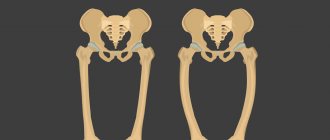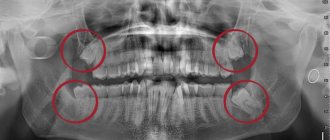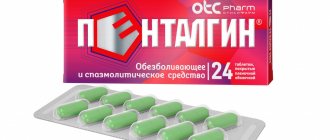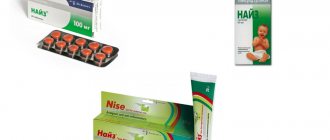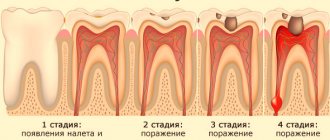Abdominal pain in children can have a variety of causes. There are pains caused by organic changes in the gastrointestinal tract. Abdominal pain can be caused by non-organic causes - these are functional disorders (colic in infants), psychosomatic pain, abdominal pain due to intolerance to any foods and, finally, abdominal pain that is not related to damage to the gastrointestinal tract (urinary tract infection , diabetes mellitus, enlarged mesenteric lymph nodes, spasm of mesenteric vessels, enlarged liver, spleen in hemoblastoses, and systemic diseases).
Side effects
When using the drug, the following side effects are rarely possible:
From the gastrointestinal tract: nausea, vomiting, discomfort or pain in the epigastrium, laxative effect, the occurrence of erosive and ulcerative lesions, bleeding.
From the nervous system: headache, dizziness, psychomotor agitation, insomnia.
From the hematopoietic organs: anemia, thrombocytopenia, agranulocytosis, leukopenia.
From the urinary system: impaired renal function, cystitis.
Allergic reactions: skin rash, itching, urticaria, exacerbation of bronchial asthma, angioedema, anaphylactoid reactions, anaphylactic shock, bronchospasm, fever, erythema multiforme exudative (including Stevens-Johnson syndrome), toxic epidermal necrolysis (Lyell's syndrome).
From the cardiovascular system: tachycardia, increased blood pressure.
Abdominal pain associated with pathology of the gastrointestinal tract.
Acute abdomen is a state of catastrophe in the abdomen, characterized by severe pain, barely bearable, constant, aching or frequently recurring. This condition requires immediate medical attention!!! This picture is caused by appendicitis, cholecystitis, pancreatitis, suppuration of an ovarian cyst, bleeding into the abdominal cavity, intestinal obstruction, intussusception, peritonitis, and perforated gastric ulcer.
Alarm signals:
- Severe pain, the child cries and/or squirms;
- Persistence of pain for 2-4 hours, and even more so its increase;
- Feeling unwell, cold sweat, fainting;
- Confusion.
Before the doctor arrives, put the child to bed, do not disturb him or try to give him anything to eat or drink. REMEMBER: you cannot give painkillers (analgin, nurofen, paracetamol, efferalgan), offer the child a heating pad, an ice pack, laxatives, try to give an enema, all this can lead to a worsening of the child’s condition and, as they say, “blur the clinical picture,” thereby delay timely diagnosis and timely prescribed treatment.
Gastritis, stomach ulcer, gastroesophageal reflux. Gastritis is an inflammatory disease of the stomach wall, characterized by abdominal pain and dyspeptic disorders.
The etiological factor is often Helicobacter pylori infection.
Emotional lability (conflicts in the family, school, some kind of disaster, stressful situations), malnutrition, allergic processes predispose to the development of gastritis - all this leads to an increase in the acidity of gastric juice and creates favorable conditions for infection with the microbe Helicobacter pyloricus.
Most often, the pain syndrome is accompanied by dyspeptic disorders (nausea, belching, unstable stool, constipation). An important symptom is liver enlargement associated with stagnation of bile.
There are no symptoms of chronic intoxication and changes in other organs. Physical development corresponds to age. In some children, the main symptoms of the disease are liver enlargement without pain.
A good effect for improving well-being is provided by excluding too fatty, spicy, fried foods from the diet. The same applies to baked goods. Vegetable oil, on the contrary, increases bile secretion and is recommended to be consumed more often. If, in addition to the specified diet, you increase physical activity, this is often enough for recovery and well-being.
If diet and lifestyle changes are not enough, choleretic agents are used. Your doctor should recommend specific medications.
Enteritis, colitis (enterocolitis) is an inflammatory disease of the wall of the small and large intestines, characterized by abdominal pain and diarrhea syndrome.
Chronic colitis and enterocolitis are most often associated with acute infections. In this case, the pathogen that caused the disease has already lost its significance, and the dysfunction of the intestine is supported by those morphological changes that remain after the infection.
Directions for use and doses
Rectally. The dosage for children depends on the age and body weight of the child.
Post-immunization fever: children under 1 year - 1 supp., over 1 year, if necessary, 1 more supp. in 6 hours
Fever and pain
Single dose - 5-10 mg/kg body weight 3-4 times a day. The maximum daily dose is no more than 30 mg/kg/day.
Children aged 3–9 months (5.5–8.0 kg) - 1 supp. (60 mg) 3 times within 24 hours every 6–8 hours, not more than 180 mg/day; from 9 months to 2 years (8.0–12.5 kg) - 1 sup. (60 mg) 4 times within 24 hours every 6 hours, but not more than 240 mg/day.
Duration of treatment: as an antipyretic - no more than 3 days; as a pain reliever - no more than 5 days.
If fever persists, you should consult your doctor.
The child complains of pain in the upper abdomen.
Peptic ulcer of the stomach and duodenum is an inflammatory disease that occurs with ulcerations of the mucous membrane of the stomach and duodenum. The causes and predisposing factors are the same as for gastritis.
With gastritis and peptic ulcers, gastroesophageal reflux often occurs - acidic gastric juice enters the esophagus, which is manifested by belching, pain in the stomach after eating, and heartburn.
With peptic ulcers, these symptoms are more pronounced.
Nurofen for children Suspension, 200 ml, 100/5 mg/ml, for oral administration, for children, strawberry
Interaction with other drugs
The simultaneous use of ibuprofen with the following LSAs: acetylsalicylic acid should be avoided: with the exception of low doses of acetylsalicylic acid (no more than 75 mg/day) prescribed by a doctor, since combined use may increase the risk of side effects. With simultaneous use, ibuprofen reduces the anti-inflammatory and antiplatelet effect of acetylsalicylic acid (an increase in the incidence of acute coronary insufficiency in patients receiving small doses of acetylsalicylic acid as an antiplatelet agent is possible after starting ibuprofen). Other NSAIDs, incl. selective COX-2 inhibitors: the simultaneous use of two or more drugs from the NSAID group should be avoided due to a possible increase in the risk of side effects. Use with caution simultaneously with the following drugs Anticoagulants and thrombolytic drugs: NSAIDs may enhance the effect of anticoagulants, in particular warfarin and thrombolytic drugs drugs. Antihypertensive drugs (ACE inhibitors and angiotensin II antagonists) and diuretics: NSAIDs may reduce the effectiveness of drugs in these groups. Diuretics and ACE inhibitors may increase the nephrotoxicity of NSAIDs. GCS: increased risk of gastrointestinal ulcers and gastrointestinal bleeding. Antiplatelet agents and SSRIs: increased risk of gastrointestinal bleeding. Cardiac glycosides: simultaneous administration of NSAIDs and cardiac glycosides may lead to worsening heart failure, a decrease in glomerular filtration rate and an increase in the concentration of cardiac glycosides in the blood plasma. Lithium preparations: there is evidence of the likelihood of an increase in the concentration of lithium in the blood plasma during the use of NSAIDs. Methotrexate: there is evidence of the likelihood of an increase in the concentration of methotrexate in the blood plasma during the use of NSAIDs. Cyclosporine: increased risk of nephrotoxicity when NSAIDs and cyclosporine are co-administered. Mifepristone: NSAIDs should be started no earlier than 8-12 days after taking mifepristone, as NSAIDs may reduce the effectiveness of mifepristone. Tacrolimus: when NSAIDs and tacrolimus are co-administered, there may be an increased risk of nephrotoxicity. Zidovudine : Concomitant use of NSAIDs and zidovudine may lead to increased hematotoxicity. There is evidence of an increased risk of hemarthrosis and hematomas in HIV-positive patients with hemophilia who received joint treatment with zidovudine and ibuprofen. Quinolone antibiotics: in patients receiving joint treatment with NSAIDs and quinolone antibiotics, there may be an increased risk of seizures.
Inorganic causes of abdominal pain.
Functional pain (colic in infants). Colic is paroxysmal pain in the abdomen, during which a child during the first 4 months of life screams loudly and “kicks” his legs. Colic occurs suddenly, the cry is loud and prolonged, the child’s face turns red, sometimes the feet become cold, and the hands are clenched into fists. The attack may end when the child is completely exhausted or after the passage of feces or gases.
Colic is most often caused by immaturity of the gastrointestinal tract. May be associated with errors in the diet of a nursing mother (dairy products, vegetables, nuts, coffee, grapes, etc.). Sometimes it is caused by the baby overeating or swallowing air during feeding. And sometimes, the causes of colic are more serious, for example, lactase deficiency leads to impaired digestion of milk sugar and causes increased fermentation of carbohydrates in the gastrointestinal tract. The development of intestinal dysbiosis, manifested by an increased growth of opportunistic flora and a decrease in normal microflora, leads to a violation processes of food digestion and also to increased fermentation processes in the intestines.
To prevent intestinal colic, a nursing mother must first of all follow a diet, completely excluding from the diet those foods that can lead to indigestion in the baby. Your pediatrician will tell you more about the diet. It is imperative that after feeding, and sometimes during feeding, the baby must be held vertically (“in a column”) to remove excess air that is swallowed during eating. If an attack of colic does occur in the baby, then the crying child should be picked up, pressed with his back to you, legs bent. Another option is to place him on your lap, tummy down. You can additionally place an ironed warm diaper under your stomach. A massage gives a good effect - stroking the tummy clockwise and using carminatives (dill water, plantex, etc.), you can use the installation of a gas outlet tube, all these activities help to release gases and stop colic and calm the baby.
To prevent colic or if the latter is caused by serious reasons, it is possible to prescribe drug therapy; your pediatrician will tell you what medications to give your baby in this case.
In any case, during an attack, especially the first one, the following diseases should be excluded:
- The presence of a tumor in the groin (strangulated hernia);
- Abdominal tension, pain, vomiting (“acute abdomen”).
Retention of stool for more than 1 day, blood in the stool (intestinal obstruction). In this case, an examination by a pediatrician, and sometimes a surgeon, is simply necessary.
It must be remembered that the child is examined by a pediatrician in the first month of life weekly, starting from the second month once every 14 days, then monthly. An examination by a surgeon is carried out in the first, third month of life and at 1 year, if there are no indications for more frequent consultations.
Alarm signals:
- Increased frequency and intensification of pain;
- Weight loss;
- Vomiting blood or coffee grounds.
In the treatment of gastritis and peptic ulcers, regular nutrition without overeating, the exclusion of irritating foods, the use of boiled, baked or lightly fried low-fat second courses, light dinners at least 2-3 hours before bedtime, the exclusion of sour juices and sweets are of great importance. The doctor prescribes an examination, diet and appropriate medications.
Diseases of the biliary system. Diseases of the biliary system in children, as a rule, are of microbial origin. Predisposing factors are a violation of the outflow of bile, which develops with dyskinesia of the biliary system.
Dyskenesia may be associated with dysfunction of the sphincter apparatus, blockage of the ducts or their compression. Subsequently, the presence of an inflammatory process in the ducts may be accompanied by a violation of the outflow of bile.
The contractility of the gallbladder is important.
The pain syndrome is usually accompanied by dyspeptic disorders (nausea, belching, unstable stool, constipation). An important symptom is liver enlargement associated with stagnation of bile.
There are no symptoms of chronic intoxication and changes in other organs. Physical development corresponds to age. In some children, the main symptoms of the disease are liver enlargement without pain.
A good effect for improving well-being is provided by excluding too fatty, spicy, fried foods from the diet. The same applies to baked goods. Vegetable oil, on the contrary, increases bile secretion and is recommended to be consumed more often. If, in addition to the specified diet, you increase physical activity, this is often enough for recovery and well-being.
If diet and lifestyle changes are not enough, choleretic agents are used. Your doctor should recommend specific medications.
Enteritis, colitis (enterocolitis) is an inflammatory disease of the wall of the small and large intestines, characterized by abdominal pain and diarrhea syndrome.
Chronic colitis and enterocolitis are most often associated with acute infections. In this case, the pathogen that caused the disease has already lost its significance, and the dysfunction of the intestine is supported by those morphological changes that remain after the infection.
The main clinical symptoms are abdominal pain, bloating and rumbling, impaired intestinal motility (constipation, diarrhea, or diarrhea alternating with constipation). Pain may be absent during the period of remission of the disease, but dysfunction of the intestines remains, which requires restorative treatment.
In addition, increased irritability, tearfulness, depressed mood, vascular dystonia syndrome, and a tendency to smooth muscle spasms are typical for these patients.
Rehabilitation consists of organizing nutrition according to the ability to absorb food, psychotherapy, the use of physiotherapeutic influences, and the use of astringents, enveloping, and absorbent agents. Recommendations on nutrition, daily routine, and medications can only be given by a doctor.




